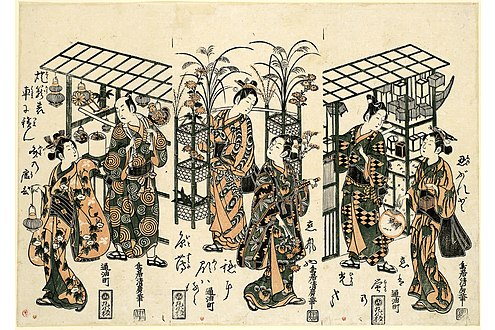Torii Kiyohiro
Torii Kiyohiro (鳥居 清広, d. c. 1776) was a Japanese artist of the Torii school of ukiyo-e.
Kiyohiro's date of birth is unknown,[1] while Ukiyo-e Ruikō lists his death date as 1776. No other evidence of those dates are known.[2]
Kiyohiro's personal name was Shichinosuke (七之助). He lived in the Sakaimachi area of Edo (modern Tokyo) and was registered as a student of Torii Kiyomasu I and likely studied under Torii Kiyonobu II or Torii Kiyomasu II.[2] Ernest Fenollosa considered him "of almost equal ability with" his contemporary Torii Kiyomitsu, and speculated they may have been brothers.[3]
Kiyohiro's first known work appeared about 1751,[4] and the last about 1764. All of his known works are benizuri-e, and though the Torii school was known for its yakusha-e actor prints, Kiyohiro also specialized in bijin-ga prints of female beauties extending into some with erotic themes.[2] He specialized in designing prints in the ōban size.[4] Two of his major sponsors/printers were Sakai-ya of Hongoku-chō, and Hōsendō of Tōri Abura-chō, both in the close neighborhood of Ichimura and Nakamura kabuki theaters.[5]
- Works by Torii Kiyohiro

Quarrel over a game of Shogi [a], Rijksmuseum

Hashira-e[b], Brooklyn Museum

Three Street Vendors[c]

Ichikawa Danjuro IV (l) and Nakamura Tomijuro I (r)[d]

Flower-like Lovers under a partially-closed Umbrella,[e] Brooklyn Museum

Sanogawa Ichimatsu (r) and Nakamura Tomijuro with an abacus (l). Rijksmuseum[f]

Nakamura Kiyosaburo as Omutsu collecting sea shells. [g]
Footnotes[]
Notes[]
- ^ Two children playing shogi chess and a grown-up male reading a book. Inscription: “Let me see”, a dialogue on the lower left; artist’s name as Torii Kiyohiro (right-to-left, bottom); printer’s name as #Sakaiya, Honkoku, bottom.
- ^ Inscription: a waka poem, top half of the picture; artist’s name, bottom right.
- ^ A set of three pictures. Right panel: A young vender selling crickets in basket, and a female customer holding a fan as a symbol for summer; a Haiku poem at the foot of the figures; artist’s name, lower right; printer’s name as Tōri Abura-chō, Yama Maruko-ban aka #Hōsendō, bottom center. Middle panel: A female vender with flowers of early fall, and a customer dressed as a samurai with a katana sword; a Haiku poem, lower left; artist’s name, bottom right; printer’s name, bottom left. Left panel: A male vender selling lanterns, and the female customer in kimono with morning glory design indicating it is summer/early fall; a Haiku poem to the left; artist’s name, bottom right; printer’s name, bottom center.
- ^ Two kabuki actors in front of a portable furnace. There are cherry blossoms and a twig of pine in the furnace. Inscription: Nakamura Tomijuro as Keishi, a kabuki role (left); a haiku poem (top middle); Ichikawa Danjuro as Sanjo, a kabuki role (right); artist’s name with two seals, bottom right; printer’s name, bottom left.
- ^ Inscriptions: Agemaki courtesan, Nakamura Tomijuro (middle right); a role name, Nakamura Shichisaburo (middle left); artist’s name with a seal (middle far right); printer’s name as Tōri Abura-chō, #Hōsendō Maruya, yama Maruko-ban.
- ^ Inscription: Ema Koshiro, the role name, Sanogawa Ichimatsu, a kabuki actor (top middle, right); Kisegawa, the role name, Nakamura Tomijuro, a kabuki actor (top middle, left); artist’s name, bottom right; printer’s name, Hammoto with red seal. Rijksmuseum.
- ^ Inscription: Omutsu, role name; Nakamura Kiyoshiro, kabuki actor (middle right); artist’s name (bottom left); printer’s name, Hongoku yon-chome, #Sakai-ya, Hongoku (bottom right). Rijksmuseum.
References[]
- ^ Fujisawa 2006, p. 19; Japan Ukiyo-e Association 1982, p. 84.
- ^ Jump up to: a b c Fujisawa 2006, p. 19.
- ^ Fenollosa 1896, p. 33.
- ^ Jump up to: a b Japan Ukiyo-e Association 1982, p. 84.
- ^ Fujikake 1946, pp. 101-102.
Works cited[]
- Fenollosa, Ernest (1896). The Masters of Ukioye: A Complete Historical Description of Japanese Paintings and Color Prints of the Genre School. Knickerbocker Press.
- Fujikake, Shizuya (1946). "Torii Kiyohiro". Zōtei Ukiyo-e 増訂浮世絵 (Zōho (expanded and revised) ed.). Yuzankaku. pp. 101–102.
- Fujisawa, Yukari (2006). "Kawamata Tsuneyuki". In Kobayashi, Tadashi (ed.). Ukiyo eshi retsuden 浮世絵師列伝. Bessatsu Taiyō (in Japanese). . p. 31. ISBN 9784582944938.
- Japan Ukiyo-e Association (1982). Genshoku Ukiyo-e Dai-Hyakka Jiten 原色 浮世絵大百科事典 第6巻 [Original Colour Grand Ukiyo-e Encyclopaedia]. 6. Taishūkan Publishing.
Further reading[]
- Link, Howard A.; Suzuki, Jūzō; Keyes, Roger S. (1980). Primitive Ukiyo-e from the James A. Michener Collection in the Honolulu Academy of Arts. University Press of Hawaii. ISBN 978-0-8248-0483-1.
External links[]
 Media related to Torii Kiyohiro at Wikimedia Commons
Media related to Torii Kiyohiro at Wikimedia Commons- Torii Kiyohiro at ukiyo-e.org
- Torii Kiyohiro at Cultural Heritage Online, the Agency for Cultural Affairs, Japan.(Japanese)
- 1776 deaths
- Torii school
- Ukiyo-e artists






